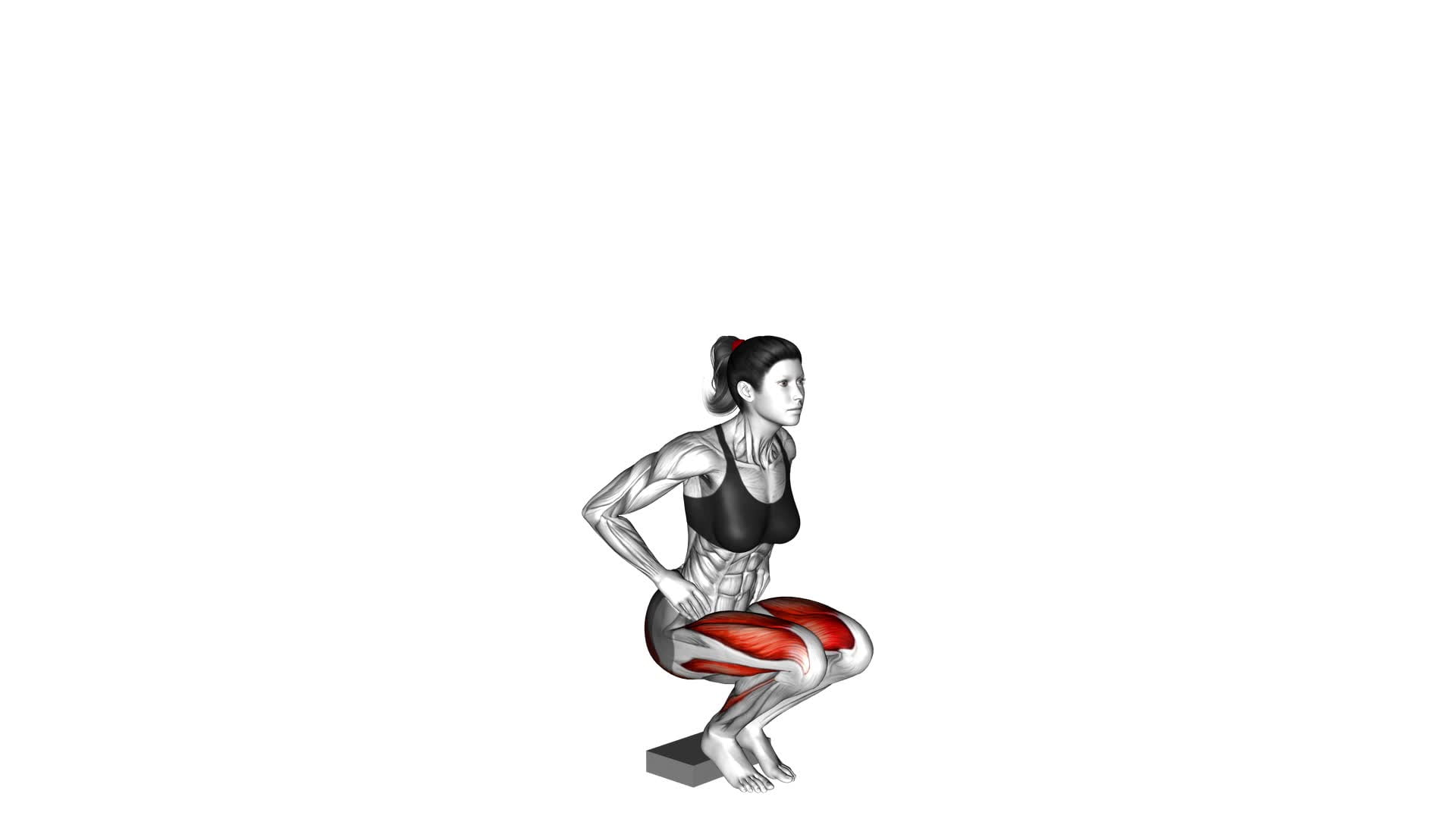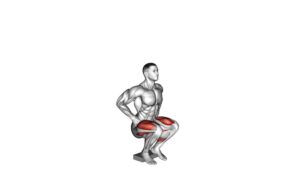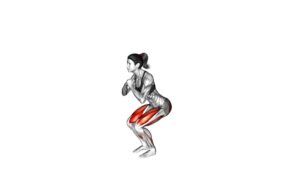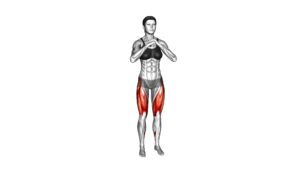Narrow Squat From Deficit (Female) – Video Exercise Guide & Tips

Looking to level up your squat game? Check out this video exercise guide and get ready to feel the burn with the narrow squat from deficit.
Watch This Exercise Video
This challenging variation targets your quads and glutes while improving stability and balance.
Learn the proper technique, avoid common mistakes, and maximize your results with helpful tips.
Grab your mat, press play, and get ready to sculpt those legs!
Key Takeaways
- Increased lower body strength and improved stability
- Targets quadriceps, hamstrings, and glutes for enhanced muscle activation in targeted areas
- Proper technique and form include maintaining a stable core, engaging lower body muscles, and using a raised platform for the deficit
- Variation and progressions include using additional resistance like dumbbells or a barbell, incorporating a resistance band for glute engagement, and performing single-leg narrow squats or step-ups for added challenge
Benefits of Narrow Squat From Deficit
You'll experience increased lower body strength and improved stability with the narrow squat from deficit. This exercise specifically targets your quadriceps, hamstrings, and glutes, leading to enhanced muscle activation in these areas. By performing the narrow squat from a deficit, where your heels are elevated on a platform, you can achieve an increased range of motion in your lower body. This deeper squat position allows for greater activation of the muscles and helps you develop stronger and more stable legs.
The narrow squat from deficit primarily focuses on your quadriceps, which are the muscles on the front of your thighs. This exercise engages these muscles to a higher degree than a regular squat, leading to greater muscle activation and growth. Additionally, the elevated heels encourage a deeper squat, resulting in increased activation of your hamstrings and glutes.
By incorporating the narrow squat from deficit into your workout routine, you can expect to see improvements in your lower body strength and stability. This exercise challenges your muscles in a different way, promoting muscle growth and enhancing your overall leg power. It also helps to improve your balance and proprioception, making it a valuable addition to any training program.
Now that you understand the benefits of the narrow squat from deficit, let's dive into the next section, which will cover proper technique and form to ensure you perform this exercise correctly and safely.
Proper Technique and Form
To perform the narrow squat from deficit with proper technique and form, focus on maintaining a stable core and engaging your lower body muscles. This exercise is often misunderstood, so let's address some common misconceptions.
Firstly, many people believe that a deficit is required to perform this squat variation. However, the term 'deficit' refers to standing on a raised platform, such as weight plates, which increases the range of motion. It isn't necessary for beginners, but can be added as you progress. As for equipment needed, you'll only require a barbell and optional weight plates for added resistance.
Now, let's dive into the proper technique. Begin by standing with your feet shoulder-width apart, toes pointing slightly outward. Keep your chest up, and engage your core. Slowly lower your body by bending your knees and pushing your hips back. Go as low as you can while maintaining proper form, making sure your knees don't extend past your toes. Push through your heels to return to the starting position. Remember to breathe and maintain control throughout the movement.
Variation and Progressions
To progress and vary the narrow squat from deficit, incorporate different loading patterns and implement unilateral movements. This won't only challenge your muscles in new ways but also help to improve your overall strength and stability. Here are some modification options and muscle activation techniques you can try:
- Loading Patterns:
- Use dumbbells or a barbell to add external resistance and increase the intensity of the exercise.
- Try using a resistance band around your thighs to engage your glutes and add extra resistance to the movement.
- Use a weight plate or kettlebell held at your chest to challenge your core stability and upper body strength.
- Unilateral Movements:
- Perform single-leg narrow squats from deficit to further enhance balance, stability, and coordination.
- Incorporate step-ups onto an elevated surface using one leg at a time to target each leg individually and improve overall lower body strength.
- Try Bulgarian split squats, where one foot is elevated behind you, to challenge your quadriceps, glutes, and balance.
Common Mistakes to Avoid
Be cautious of falling into common mistakes when performing the narrow squat from deficit exercise. By being aware of these mistakes, you can ensure that you're performing the exercise correctly and effectively.
One common mistake isn't maintaining proper form throughout the movement. It's important to keep your chest up, back straight, and knees aligned with your toes to prevent injury and maximize results.
Another mistake to avoid is using too much weight. Start with a lighter weight and gradually increase as you gain strength and confidence. Using too much weight can compromise your form and increase the risk of injury.
Additionally, failing to modify or adapt the exercise to suit your fitness level can also be a mistake. If the deficit is too challenging, consider using a smaller platform or starting with a regular narrow squat before progressing to the deficit variation.
Tips for Maximizing Results
To maximize your results, incorporate these tips into your narrow squat from deficit routine:
- Vary the weights: To maximize muscle growth, it's important to challenge your body with different weights. Gradually increase the weight as you progress to keep pushing your muscles to adapt and grow.
- Focus on form: Proper form is crucial for targeting the right muscles and avoiding injury. Make sure to maintain a straight back, keep your knees aligned with your toes, and go as low as you comfortably can while maintaining good form.
- Time your workouts: The best time to perform the narrow squat from deficit exercise is during your leg day or lower body workout. This allows you to give your full energy and focus to this specific exercise, maximizing its effectiveness.
By following these tips, you can maximize the results of your narrow squat from deficit routine.
Varying the weights challenges your muscles, while maintaining proper form ensures you target the right muscles and minimize the risk of injury. Additionally, scheduling this exercise during your leg day or lower body workout allows you to give it your full attention and effort.
Keep pushing yourself and watch your muscles grow stronger and more defined.
Frequently Asked Questions
How Many Reps and Sets Should I Do for the Narrow Squat From Deficit Exercise?
For the narrow squat from deficit exercise, you should aim for 3-4 sets of 8-12 reps.
Start with a weight that challenges you but allows you to maintain proper form.
Keep your feet close together and your heels elevated on a platform.
As you progress, you can increase the weight or try different variations, like adding a pulse at the bottom of the squat.
Remember to always prioritize form and listen to your body to avoid injury.
Can I Do the Narrow Squat From Deficit Exercise Without Using Weights?
Yes, you can definitely do the narrow squat from deficit exercise without using weights. It's a great alternative exercise that still offers many benefits.
By performing this exercise without weights, you can focus on improving your form, balance, and stability. Additionally, it can help you build lower body strength and endurance.
What Muscles Does the Narrow Squat From Deficit Primarily Target?
The narrow squat from deficit primarily targets your quadriceps, hamstrings, and glutes. By incorporating this exercise into your leg workout routine, you can benefit from increased strength and muscle tone in your lower body.
It's a great way to challenge yourself and improve your overall fitness level. Depending on your fitness level, you can modify the exercise by adding weights or adjusting the depth of the deficit.
Is the Narrow Squat From Deficit Exercise Suitable for Beginners?
Yes, the narrow squat from deficit exercise is suitable for beginners.
To perform it with proper form and technique, start by standing on a raised surface, like a step or block. Place your feet close together, shoulder-width apart.
Lower your body down into a squat position, keeping your back straight and core engaged.
As you gain strength and confidence, you can progress by increasing the height of the deficit or adding weights.
How Often Should I Incorporate the Narrow Squat From Deficit Exercise Into My Workout Routine?
To incorporate the narrow squat from deficit exercise into your workout routine, start by determining your fitness level. If you're a beginner, it's important to gradually introduce this exercise and focus on proper form.
As you progress, you can increase the frequency of incorporating narrow squats into your routine. Additionally, you can modify the exercise by using lighter weights or performing bodyweight squats.
Remember to listen to your body and make adjustments as needed to ensure a safe and effective workout.
Conclusion
In conclusion, the narrow squat from a deficit is a highly effective exercise for females looking to strengthen their lower body.
By maintaining proper technique and form, utilizing variations and progressions, and avoiding common mistakes, you can maximize the results of this exercise.
Remember to stay focused and consistent in your training to achieve the desired outcomes.

Author
Years ago, the spark of my life’s passion ignited in my mind the moment I stepped into the local gym for the first time. The inaugural bead of perspiration, the initial endeavor, the very first surge of endorphins, and a sense of pride that washed over me post-workout marked the beginning of my deep-seated interest in strength sports, fitness, and sports nutrition. This very curiosity blossomed rapidly into a profound fascination, propelling me to earn a Master’s degree in Physical Education from the Academy of Physical Education in Krakow, followed by a Sports Manager diploma from the Jagiellonian University. My journey of growth led me to gain more specialized qualifications, such as being a certified personal trainer with a focus on sports dietetics, a lifeguard, and an instructor for wellness and corrective gymnastics. Theoretical knowledge paired seamlessly with practical experience, reinforcing my belief that the transformation of individuals under my guidance was also a reflection of my personal growth. This belief holds true even today. Each day, I strive to push the boundaries and explore new realms. These realms gently elevate me to greater heights. The unique combination of passion for my field and the continuous quest for growth fuels my drive to break new ground.







